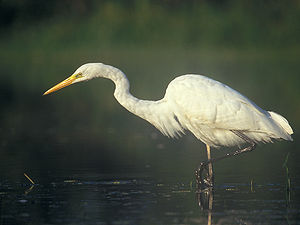Difference between revisions of "Field Guide/Birds/Ardea alba"
m (162 revisions: re-import from WB, including edit history) |
|||
| (123 intermediate revisions by 20 users not shown) | |||
| Line 1: | Line 1: | ||
| − | {{ | + | {{Bird id |
| − | + | | name = Great Egret | |
| − | + | | latin_name = Ardea alba | |
| − | + | | level = 4 | |
| − | + | | image_1 = Egretta alba 1 (Lukasz Lukasik).jpg | |
| − | + | | caption_1 = Great Egret | |
| − | + | | description = The '''Great Egret''' ''Ardea alba'', also known as the '''Great White Egret''', '''White Heron''', or '''Common Egret''', is a wading egret, found in most of the tropical and warmer temperate parts of the world, although it is very local in southern Europe and Asia. It is called '''Kōtuku''' in New Zealand. It should not be confused with the Great White Heron, which is a white morph of the Great Blue Heron found in Florida. | |
| − | |||
| − | |||
| − | |||
| − | |||
| − | |||
| − | |||
| − | The | + | The Great Egret is a large bird with all white plumage, as much as {{units|101 cm|40 in}} long and weighing up to {{units|950 grams|2 lbs}}. It is only slightly smaller than the Great Blue or Grey Herons. Apart from size, the Great Egret can be distinguished from other white egrets by its yellow bill and black legs and feet. It also has a slow flight, with its neck retracted. This is characteristic of herons and bitterns, and distinguishes them from storks, cranes and spoonbills, which extend their necks. |
| − | The Great | + | The Great Egret feeds in shallow water or drier habitats, spearing fish, frogs or insects with its long, sharp bill. It will often wait motionless for prey, or slowly stalk its victim. It is a conspicuous species, usually easily seen. |
| − | + | The Great Egret is partially migratory, with northern hemisphere birds moving south from areas with cold winters. It breeds in colonies in trees close to large lakes with reed beds or other extensive wetlands. It builds a bulky stick nest. The call at breeding colonies is a loud croaking "cuk cuk cuk". | |
| − | + | }}<noinclude>[[Category:Adventist Youth Honors Answer Book/Transcluded Modules|{{FULLCHAPTERNAME}}]]</noinclude> | |
| − | The Great Egret is partially | ||
| − | |||
| − | |||
| − | |||
| − | |||
| − | |||
| − | |||
| − | |||
| − | |||
| − | |||
| − | |||
| − | |||
| − | |||
| − | |||
| − | |||
| − | |||
| − | |||
| − | |||
| − | |||
| − | |||
| − | |||
| − | |||
| − | |||
| − | |||
| − | |||
| − | |||
| − | |||
| − | {{ | ||
| − | |||
| − | |||
| − | |||
| − | |||
| − | |||
| − | |||
| − | |||
| − | |||
| − | |||
| − | |||
Latest revision as of 19:09, 5 July 2012
| Ardea alba (Great Egret) | |
|---|---|
| Description | |
| The Great Egret Ardea alba, also known as the Great White Egret, White Heron, or Common Egret, is a wading egret, found in most of the tropical and warmer temperate parts of the world, although it is very local in southern Europe and Asia. It is called Kōtuku in New Zealand. It should not be confused with the Great White Heron, which is a white morph of the Great Blue Heron found in Florida.
The Great Egret is a large bird with all white plumage, as much as 101 cm The Great Egret feeds in shallow water or drier habitats, spearing fish, frogs or insects with its long, sharp bill. It will often wait motionless for prey, or slowly stalk its victim. It is a conspicuous species, usually easily seen. The Great Egret is partially migratory, with northern hemisphere birds moving south from areas with cold winters. It breeds in colonies in trees close to large lakes with reed beds or other extensive wetlands. It builds a bulky stick nest. The call at breeding colonies is a loud croaking "cuk cuk cuk". | |

